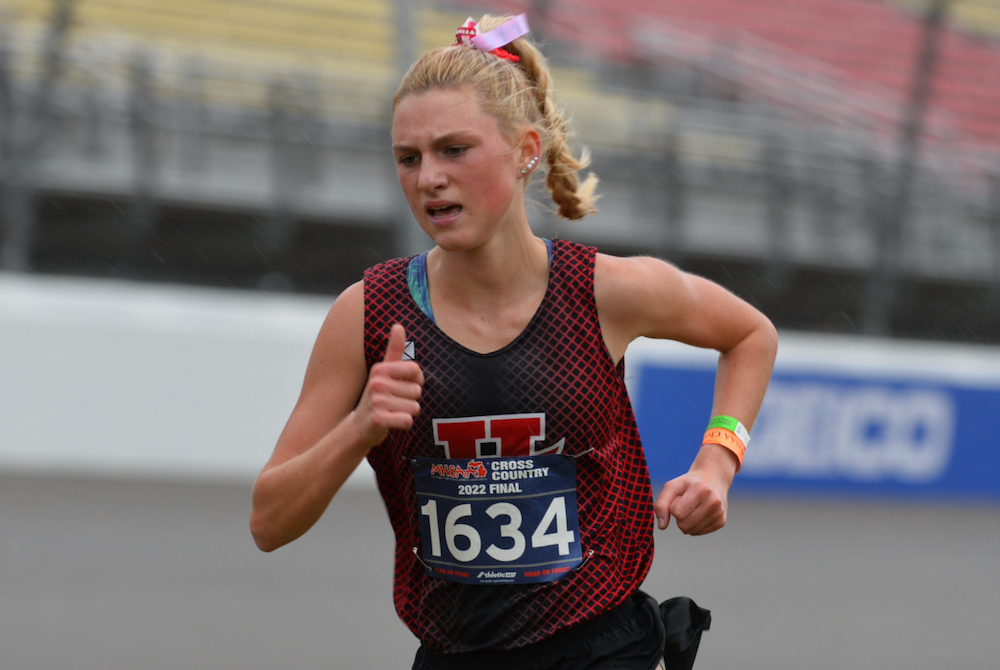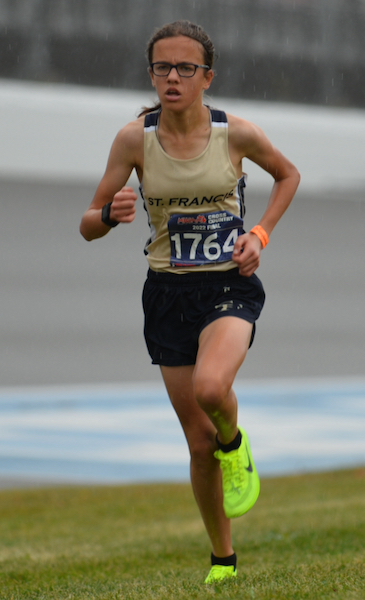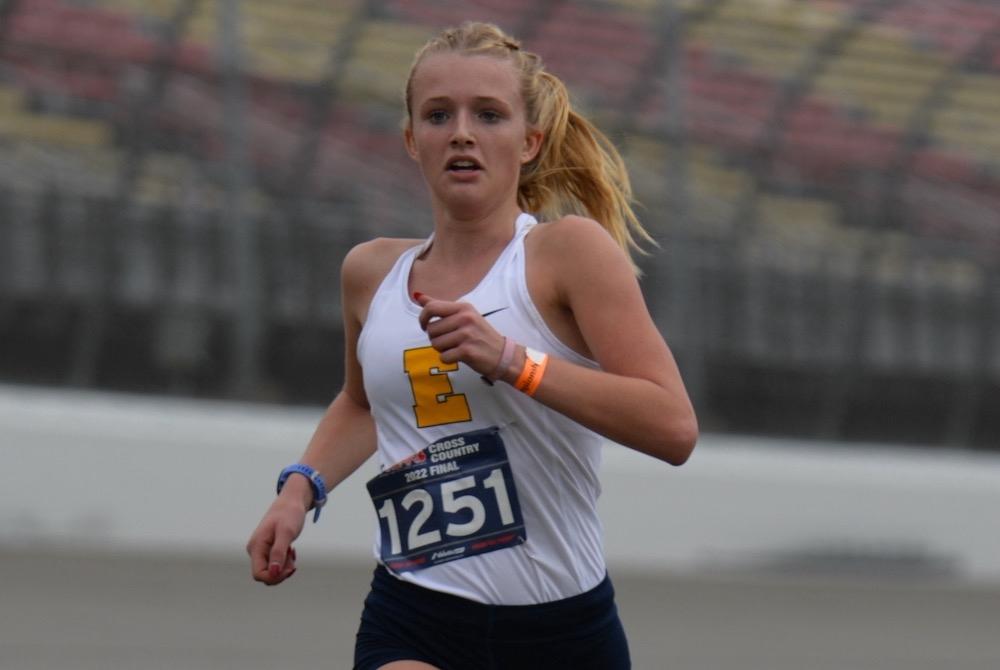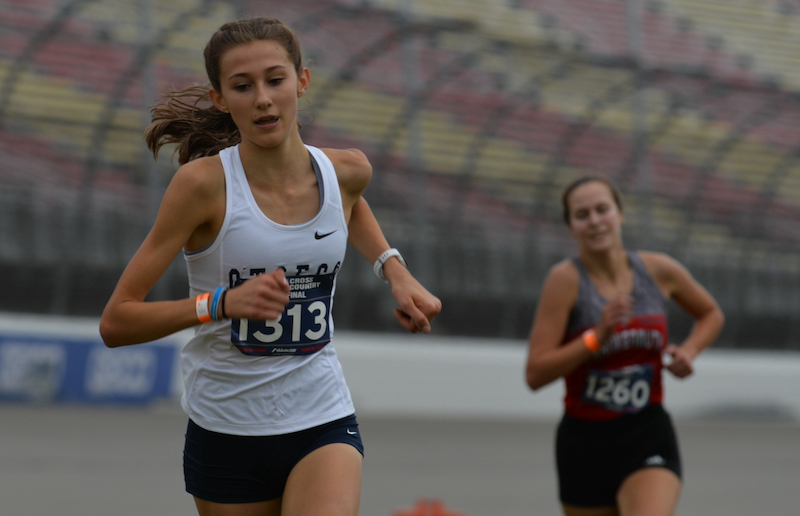
Jazwinski Brings Hart Individual Title as St. Francis Moves to Front of Team Pack
November 5, 2022
BROOKLYN – Cross country races can be won between the ears before runners ever step foot onto the course.
Attitudes were tested as rain began to descend on Michigan International Speedway and the wind picked up just before the start of the MHSAA Lower Peninsula Division 3 girls race late Saturday morning.
Hart sophomore Jessica Jazwinski was loving life as she prepared to race.
“As a distance runner, I really try to love the wind,” she said. “Distance running and cross country is just a tough sport. The wind just adds to it — and the rain, too. It’s super fun.
“I was just thinking these conditions are just gonna feed my great race. This is real cross country. Yeah!”
Jazwinski overcame the elements to run the fifth-fastest Division 3 time ever, winning with a time of 17:36.70. She has two of the top-five times in Division 3 Finals history, having run 17:31.4 to place third last year.
“Today my race plan was just to go out hard and try to hold on to my pace,” she said. “I feel like I tried to race a lot like Steve Prefontaine, just go out and hold on.”
 Lansing Catholic senior Hannah Pricco was second in 18:17.59, Onsted sophomore Emmry Ross was third in 18:20.96 and Hart junior Alyson Ens was fourth in 18:28.52.
Lansing Catholic senior Hannah Pricco was second in 18:17.59, Onsted sophomore Emmry Ross was third in 18:20.96 and Hart junior Alyson Ens was fourth in 18:28.52.
“I love having great teammates to work with and encourage each other,” Jazwinski said. “We really try to encourage each other so much throughout the races. Throughout this year, some races she’s been a minute behind me, some races she’s been five seconds. I don’t want her to ever beat me, so that pushes me so much. I know she’s trying to race me and get up there with me.”
The only downer for Hart was having its string of Division 3 championships end at five with a fourth-place finish. Hart had two runners in the top four, but its No. 3 runner was 68th.
“I would totally trade my individual title for a team title,” Jazwinski said.
Traverse City St. Francis emerged from a close battle to win its first title since 2016 with 134 points. Pewamo-Westphalia was second with 142 and Lansing Catholic third with 165.
Sophomore Betsy Skendzel led St. Francis, placing seventh in 18:48.33. Completing the team score were senior Sophia Rhein in 26th (19:43.27), sophomore Grace Slocum in 33rd (20:07.95), junior Rylee Duffing in 60th (20:44.82) and junior Margot Hagerty in 63rd (20:45.78).
Lansing Catholic had three place in the top 10, but didn’t get another finisher until 103rd.
PHOTOS (Top) Hart’s Jessica Jazwinski pushes toward the finish during Saturday’s LPD3 Final. (Middle) Traverse City St. Francis’ Betsy Skendzel leads the way for the eventual team champion. (Click for more from Dave McCauley/RunMichigan.com.)

Past Races Pay Off for EGR's Muller, While Otsego Rises Again as Top Team
November 5, 2022
BROOKLYN – How strong of a cross country conference is the Ottawa-Kent Conference White?
So good that Drew Muller of East Grand Rapids didn’t even win the two conference jamborees she raced this season.
Yet, she was first when it mattered the most, winning the MHSAA Lower Peninsula Division 2 championship Saturday at Michigan International Speedway.
Muller crossed the finish line in 18:18.47 to win by 9.36 seconds over Otsego freshman Emma Hoffman.
The winner of all three O-K White jamborees was Grand Rapids Christian junior Natalie VanOtteren, who was fourth in 17:55.3. Six of the top 10 runners were from the Grand Rapids area.
“It’s been like this a lot during the season,” Muller said. “All the teams we race against in our conference are so stacked. Everyone who runs there is so amazing, so it makes it fun.
“It helps so much. Everyone we race against are such good friends. It makes it even more fun. It makes you love the sport even more.”
 Muller ran with some familiar faces much of the race before making a break entering the track with one kilometer remaining.
Muller ran with some familiar faces much of the race before making a break entering the track with one kilometer remaining.
“I was feeling pretty fatigued, but I found my group I run with a lot and we stuck with it together and kind of powered through,” she said. “In the back stretch, I took a chance and went at the 1K, which I’ve been doing in a couple meets before this. It’s worked pretty well. I was pretty fatigued, but it’s good, good to be done.”
Muller’s first words with reporters after the race were, “That hurt a lot.”
Muller became an MHSAA champion after finishing fifth in Division 2 both of the last two years. She applied lessons learned from her first two trips around the MIS course to put it all together Saturday.
“My past races were pretty rough,” she said. “It was definitely a learning experience.
“Definitely in the past, I’ve gone out a little bit faster as we entered the stadium. I feel there’s so much energy, it’s kind of hard not to. A lot of people I race also go out really fast, so I try to go with them. That didn’t really help in the past. This year, I feel like I have more endurance to keep up and have a good kick.”
The only title that eluded Muller was the team championship, something East Grand Rapids captured last year and three of the last four seasons.
Instead, it was Otsego that returned to the top for the first time since winning back-to-back championships in 2015 and 2016.
The Bulldogs scored 87 points to beat East Grand Rapids by 11. Grand Rapids Christian was third with 153.
Otsego put four runners in the top 14. Hoffman was second in 18:27.83, junior Logan Brazee was seventh in 18:42.95, junior Megan Germain was eighth in 18:47.56 and sophomore Taylor Mitchell was 14th in 18:57.08. No. 5 runner Rebekah Stachura crossed in 86th place in 20:12.64 to complete the team score.
East Grand Rapids had three runners in the top 15, then got a 39th and a 55th from its other two scoring runners.
PHOTOS (Top) East Grand Rapids’ Drew Muller charges toward the finish line during the LPD2 Final. (Middle) Otsego’s Emma Hoffman, left, and Frankenmuth’s Mary Richmond follow Muller down the stretch to finish second and third, respectively. (Click for more from Dave McCauley/RunMichigan.com.)

